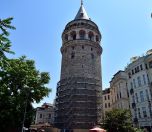* Photos: Anadolu Agency (AA)
Click to read the article in Turkish
The Ministry of Culture and Tourism has announced that the restoration works at Galata Tower will be postponed until swift birds migrate.
Located in Beyoğlu, İstanbul and a popular destination for tourists and locals, Galata Tower is home to swift birds, which use the tower also as a breeding ground. In the wake of restoration and museumization works that started at the tower, concerns were raised for the birds living and breeding there.
Amid these objections and concerns, Minister of Culture and Tourism Mehmet Nuri Ersoy shared a brief message on Twitter yesterday (July 6):
"We could not have remained insensitive to swift birds during museumization works at Galata Tower. We have paused the maintenance works at the facade of the tower till the birds migrate.
"Moreover, the museum will have a special section for the birds of Galata. I would like to thank everyone who showed sensitivity."
CLICK - Ministry of Tourism Takes Over Galata Tower from İstanbul Municipality
What happened?
As Galata Tower is one of the places where swift birds lay their nest and breed, the restoration works that started at the tower caused concerns over the possible effects of these works on the birds. Several messages were shared on social media, calling on the authorities to stop the restoration.
İstanbul Bar Association Human Rights Center Chair lawyer Deniz Tavşancıl said, "What you call culture is not solely about buildings, it is also culture with its nature and life experiences." Accordingly, she applied to the Ministry of Tourism and Culture and requested the halt of restoration.
Simurg Bird Nest Association also said that the restoration should be postponed until the breeding season of the birds was over. The Association applied to the Presidency Communication System (CİMER) with this request.
About swift birdsOnline encyclopedia Britannica shares the following information in brief: "Swift, any of about 75 species of agile, fast-flying birds of the family Apodidae (sometimes Micropodidae), in the order Apodiformes, which also includes the hummingbirds. Almost worldwide in distribution, swifts are absent only from polar regions, southern Chile and Argentina, New Zealand, and most of Australia. "Closely resembling swallows, swifts range in length from about 9 to 23 cm (3.5 to 9 inches). They have exceptionally long wings and chunky, powerful bodies. Their compact plumage is a dull or glossy gray, brown, or black, sometimes with pale or white markings on the throat, neck, belly, or rump. "The head is broad, with a short, wide, slightly curved bill. The tail, although often short, may be long and deeply forked. The feet are tiny and weak; with the aid of sharp claws they are used only to cling to vertical surfaces. "The fastest of small birds, swifts are believed to reach 110 km (70 miles) per hour regularly; reports of speeds three times that figure are not confirmed. The only avian predators known to take swifts with regularity are some of the larger falcons. "The nest of a swift is made of twigs, buds, moss, or feathers and is glued with its sticky saliva to the wall of a cave or the inside of a chimney, rock crack, or hollow tree. "The young stay in the nest or cling near it for 6 to 10 weeks, the length of time depending largely on the food supply. Upon fledging, they resemble the adults and immediately fly adeptly." |
(EKN/SD)




.jpg)


-132.jpg)

